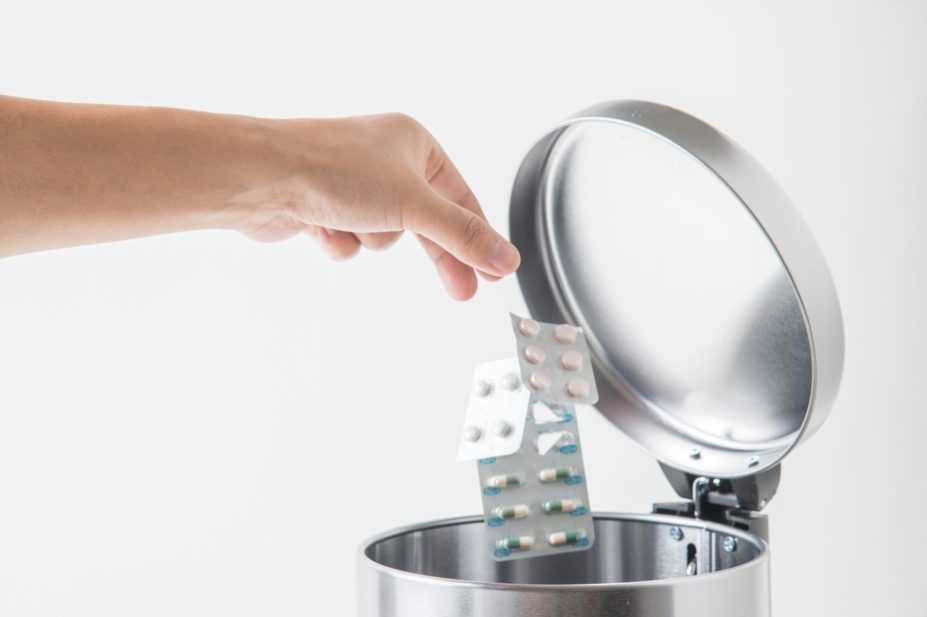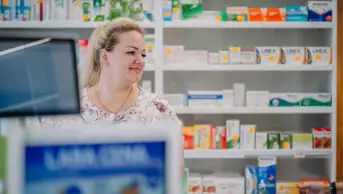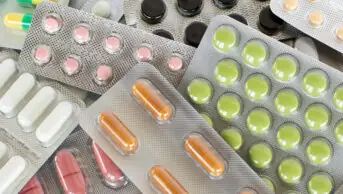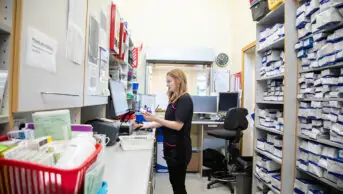
Shutterstock.com
In July 2018, we — a group of researchers at the University of Reading — spoke to The Pharmaceutical Journal about why we should reuse returned medicines[1]
. However, despite our research supporting the practice, it remained illegal in community settings. Valuable medicines, unused by those they were prescribed for, continued to be destroyed.
That was until the COVID-19 pandemic hit. On 28 April 2020, the UK government unexpectedly changed its position on medicines reuse and released guidance on the practice, allowing it only under specific circumstances during the pandemic[2]
.
Now — in settings such as care homes and hospices — some medicines that have been given to one patient, but are no longer being used, can be given to someone else instead[3]
.
After calling for the government to rethink medicines reuse for the past couple of years, we are pleased to see the new guidance. However, the government needs to go further: there are staggering savings to be made if this practice becomes legal across the board. In 2009, medicines waste was estimated to cost NHS England £300m per year — £110m of which related to medicines returned to community pharmacies for disposal[4]
.
As well as its cost, we must not forget that medicines waste also has a detrimental effect on the environment. For example, people are more likely to dispose of their unwanted medicines in the household rubbish bin, or down the drain, than return them to pharmacies, which can lead to water and ground contamination.[5]
. Creating and destroying medicines also leaves a carbon footprint[6]
.
Reusing medicines makes sense.
Fears about degradation mean all this waste amounts to a wasted opportunity
Pushback on reusing medicines
Fears about degradation mean all this waste amounts to a wasted opportunity.
Given time, all medicines can plausibly degrade through chemical decomposition, physical deterioration, or microbial contamination. Chemical reactions, such as oxidation and hydrolysis — which can break down the active pharmaceutical ingredient within a formulation — are accelerated by light, heat, and humidity[7]
. For this reason, medicines are normally subjected to stability tests, and given an expiry date and recommended storage conditions, so that they are used safely and effectively[8]
.
Normally, medicines are not allowed to be reused within a community setting, owing, mainly, to worries that returned items could have declined in quality[9]
. The medicine may not have been kept at the right temperature, or it may have been exposed to too much light or moisture, which could accelerate its breakdown and loss of potency.
Not knowing where and how a medicine might have been stored after it left the pharmacy puts its continued quality in question. Under normal circumstances, these reservations provide sufficient grounds for medicine regulators to reject the idea of medicines reuse.
Tackling drug shortages takes precedence
So, what has changed? Since the onset of the pandemic, supplies from overseas manufacturers have reduced, while demand for medicines has naturally increased in both community and hospital settings; the government’s U-turn on the reuse of medicines is an attempt to mitigate medicines supply issues, which were already a growing global concern before COVID-19 took hold[10]
,[11]
.
Manufacturers were asked to retain Brexit medicines stockpiles and companies have been banned from exporting certain medicines out of the UK[12]
,[13]
. Suddenly, the risk of reusing medicines does not seem as large as the risk of not having any medicines at all.
Where is the proof that modern packaging fails to protect against some fluctuations in a medicine’s storage environment?
We trust patients to look after their medicines
Unused medicines that would otherwise have been returned and destroyed can be put to good use in care homes and hospices during the pandemic — a practice we have supported for some time. We have noted that medicines can degrade in high heat, humidity and light, and we argue that, precisely for this reason, drug companies should package tablets and capsules into airtight blister packs within cardboard boxes[14]
.
After all, where is the proof that modern packaging fails to protect against some fluctuations in a medicine’s storage environment? And why do we trust patients to look after their medicines at home, and that the medicines will maintain their quality, if we have fears about their degradation?[1]
.
There has not yet been a widescale investigation into how and where patients store their medicines at home. And we don’t have a clear idea of what happens (if anything) to most medicines kept inside their original packaging, outside of a pharmacy setting, for different amounts of time, but within the expiry date. The question of whether reuse is safe is not easy to answer, but we have tried.
Investigating the safety of returned medicines
We know from our own work on a small sample of tablets that for those left in their original packaging, but stored in hot and humid conditions for a month, there are at least some physical changes[15]
.
For example, one brand of atenolol (beta blocker) tablets became harder when stored at 40ºC and 75% humidity, compared with storage at room temperature. However, for these, tablet friability (the ability to break down into smaller pieces) and dissolution were not affected, and the results for disintegration time were inconclusive.
Another brand of atenolol tablets kept in their original packaging became softer when stored at 40ºC and 75% humidity, and took on a visibly moist appearance too. Friability and dissolution were not affected with this brand, but we found a significantly faster disintegration time after storage at the higher temperature and humidity. Despite these changes, the chemical stability of our sample was not affected under any of the storage conditions, so it was difficult to conclude that storage at 40ºC and 75% humidity affected the bioavailability of these samples.
These small laboratory tests are, of course, no match for the formal stability studies completed by drug manufacturers. Existing stability data from manufacturers likely provide enough information for regulators to infer new expiry dates for reused medicines[16]
.
Putting procedures in place
We need to learn from this challenge as we dare to look beyond the current pandemic
During the current pandemic, the government suggests that care homes and hospices draw up standard operating procedures in case they have to reuse some medicines[2]
. The proposals warrant careful reading, as they are quite complex — for example, if an urgent medicine is out of stock, there is still a requirement for an alternative to be prescribed and dispensed if possible. If there is not an alternative, the pharmacy can explore the possibility of reusing the medicine with the care home or hospice. Importantly, the proposed medicine should no longer be needed by the original recipient; both parties (or their representatives) must consent to the reuse. There are also measures in place to prevent cross-contamination with COVID-19 through the packaging of the reused medicine.
Under the new proposals, registered healthcare professionals (e.g. pharmacists, pharmacy technicians, general practitioners and community nurses) must also inspect the medicines to make sure they are suitable for reuse[2]
. However, completed in person or virtually, these checks can provide only a physical assessment, which does not guarantee the quality or amount of the medicines inside. We need to learn from this challenge as we dare to look beyond the current pandemic.
Time for a reset on how we practise
The pandemic is providing an opportunity to rethink the way we do a lot of things in healthcare, including medicines reuse. It is not implausible that the government should widen medicines reuse to include dispensing in community pharmacies, if the pharmaceutical supply chains were to become further compromised. In this case, pharmacists will need a checklist for taking in and giving out returned medicines, which should include giving visual checks and asking questions about storage.
Any checklist should take account of our definition of medicines reuse, which we developed through qualitative interviews with members of the public, to ensure their understanding. This definition is: using one patient’s unwanted and returned medication for another patient, if the medication has more than six months’ shelfâ€life remaining and has been kept untampered for less than three months, under normal storage conditions, in its original sealed blister packaging[3]
.
Developing a checklist will not be the only issue — it remains unclear how many pharmacies are fully compliant with the Falsified Medicines Directive. Where the directive has been fully implemented, there will be barriers to formally taking and scanning products back into the system, as well as practical issues around drug reimbursement and remuneration.
We want to make the intelligent reuse of medicines easy by technologising the packaging of pharmaceuticals
Everything connected
In the future, beyond the COVID-19 pandemic, we want to make the intelligent reuse of medicines easy by technologising the packaging of pharmaceuticals[17]
.
You may be aware of the ‘Internet of Things’: the idea that objects connected by the internet can ‘talk’ to each other and to us[18]
. Our ambition is to add drug packaging to this network by embedding sensors of temperature and humidity, to validate the quality of returned medicines. Printed electronics with connectivity to the internet will enlist medicines as part of the new ‘Internet of Pharmaceutical Things’[19]
.
We hope this network will allow the validation of the quality and safety of returned medicines, make the process of reusing medicines safer and more robust, and improve the uptake of medicines reuse by the general public. We know from our questionnaire study with more than 1,000 people that patients may be much more likely to embrace medicines reuse through practical measures, such as this, which illustrate to them the safety and quality assurance of reissued medicines[19]
.
Learning from a crisis
In the meantime, as COVID-19 dissipates, we hope that pharmaceutical supply chains will be bolstered, and that it will not be necessary to draw up new legislation for medicines reuse in community pharmacy in an emergency capacity.
But should this happen, we would have much to learn, and we must learn from what is already happening in care home and hospice settings — this knowledge could propel us into a future where we can finally address our throwaway attitude to medicines. It is time to entertain medicines reuse as a plausible and worthwhile concept.
Parastou Donyai, professor and director of pharmacy practice; Rachel McCrindle, professor of computer and human interaction; Terence Hui, postdoctoral research associate; Robert Simon Sherratt, professor of biosensors; all at the University of Reading
References
[1] Connelly D. Pharm J 2018;301(7915):20–23. doi: 10.1211/PJ.2018.20205091
[2] Department of Health and Social Care, NHS England & NHS Improvement. 2020. Available at: https://www.gov.uk/government/publications/coronavirus-covid-19-reuse-of-medicines-in-a-care-home-or-hospice (accessed June 2020)
[3] Alhamad H, Patel N & Donyai P. Int J Pharm Pract 2018;26(3):232–241. doi: 10.1111/ijpp.12391
[4] Trueman P, Lowson K, Blighe A et al. 2010. Available at: https://discovery.ucl.ac.uk/id/eprint/1350234/1/Evaluation_of_NHS_Medicines_Waste__web_publication_version.pdf article (accessed June 2020)
[5] Paut Kusturica M, Tomas A & Sabo A. Rev Environ Contam Toxicol 2017;240:71–104. doi: 10.1007/398_2016_3
[6] NHS Sustainable Development Unit. 2016. Available at: https://www.sduhealth.org.uk/policy-strategy/reporting/nhs-carbon-footprint.aspx (accessed June 2020)
[7] Snape TJ, Astles AM & Davies J. Pharm J 2010;285(416)
[8] World Health Organization. 2018. Available at: https://extranet.who.int/prequal/sites/default/files/documents/TRS1010_Annex10.pdf (accessed June 2020)
[9] British Medical Association. 2018. Available at: https://archive.bma.org.uk/collective-voice/committees/patient-liaison-group/resources/dispensed-but-unopened-medications (accessed June 2020)
[10] European University Hospital Alliance. 2020. Available at: http://www.euhalliance.eu/2020/03/31/university-hospitals-urgently-call-for-more-european-collaboration-to-prevent-drug-shortages/ (accessed June 2020)
[11] Hill A. Pharm J. 2020;304(7936):246–247. doi: 10.1211/PJ.2020.20207897
[12] Department of Health and Social Care. 2020. Available at: https://www.gov.uk/government/news/crucial-medicines-protected-for-coronavirus-covid-19-patients (accessed June 2020)
[13] Department of Health and Social Care. 2020. Available at: https://assets.publishing.service.gov.uk/government/uploads/system/uploads/attachment_data/file/881007/Medicines_that_cannot_be_exported_from_the_UK_or_hoarded_23.csv (accessed June 2020)
[14] Donyai P. 2018. Available at: https://research.reading.ac.uk/research-blog/medicines-is-it-time-to-challenge-the-throw-away-culture/ (accessed June 2020)
[15] Donyai P. J Clin Pharm Ther 2010;35(5):533–543. doi: 10.1111/j.1365-2710.2009.01129.x
[16] International Conference on Harmonisation of Technical Requirements for Registration of Pharmaceuticals for Human Use. 2003. Available at: https://database.ich.org/sites/default/files/Q1E%20Guideline.pdf (accessed June 2020)
[17] Hui TKL, Mohammed B, Donyai P et al. Pharmacy 2020;8(2):58. doi: 10.3390/pharmacy8020058
[18] Burgess M. 2018. Available at: https://www.wired.co.uk/article/internet-of-things-what-is-explained-iot (accessed June 2020)
[19] Hui TKL, Donyai P, McCrindle R & Sherratt SR. Sensors 2020;20(11):3080. doi: 10.3390/s20113080


